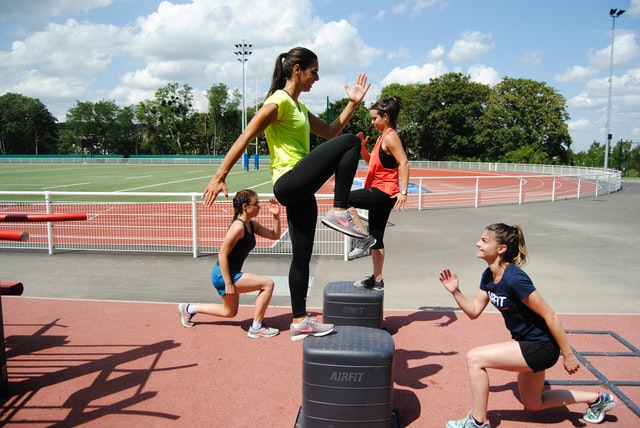Gym Culture in the US and Spain: A Field Study


The average male of the species is characterized by several distinct, immutable traits. To use local dialect, he has a superguay (very cool) trendy haircut, multiple piercings, and for some inexplicable reason, wears an NBA basketball jersey (Go Lakers?). Perhaps the defining characteristic of the gym-going salmantino is a preference for Spandex short shorts. Legs are a source of pride for the male gym-goer in Salamanca. Perhaps they are used to attract mates? What they lack in muscle definition, they make up for by being impeccably shaved. As a point of reference, I examined my own cactus-inspired legs. Yikes.
Physically, male gym-goers in Salamanca vary in shape and size. My observations have found that it is common for males to be top-heavy; they have broadly defined shoulders, muscular arms, and disproportionately skinny legs. I guess everyone feels like skipping leg day in Spain.
Gym Culture in the US and Spain: A Field Study.
My previous field research has studied gym goers in the coastal region of New Jersey (otherwise known as “The Shore”). The bros native to this particular region are larger, stronger, and display an adroit ability to use complex tools (such as the lat pull-down or the squat rack). Strangely, they show an inordinate fascination with removing the sleeves from their T-shirts. They subsist on a diet almost exclusively made up of whey protein and Gatorade.
It seems weird not to comment on the female members of the species. However, the truth is that there are very few women at my gym in Salamanca.
Spanish women don’t use the gym as much because it carries a certain stigma, according to my grammar professor. She said there are definitely “girl sports,” like spinning, jogging, and Zumba; and “boy sports,” like fútbol, basketball, and weightlifting. Rooted in machismo, the majority of women feel uncomfortable lifting weights or doing “masculine” activities at the gym.
The few women I’ve seen at my gym always wear fashionable Spandex (read: form-fitting) workout gear and have impeccable makeup. As my colleague Rebecca Doss once published in an esteemed academic journal (Twitter), “Omg the girls at this gym in Sevilla look better than I did for my senior prom.” The women who do go to my gym are almost always accompanied by a friend or boyfriend.
In certain cultures, female fitness is so stigmatized because the Western feminine beauty ideal emphasizes that women should be slim and lithe, not muscular and ripped. One study (2004) found that Physique-level female body builders felt pressure to balance being both muscular and feminine. This includes, for example, retaining a visible waist and enough breast definition to be considered “sexy” while still having insane muscles. If these Super-women athletes feel conflicted about their exercise regimens, where does that leave the average university student trying to work off last night’s cerveza and kebabs?
Gym Culture in the US and Spain: A Field Study.
At my gym in New Jersey, both sexes are fairly equally represented, although women still are in the minority. Even though my gym is decidedly more “bro-y,” female fitness definitely carries less stigma in the United States.
…Or does it?
“Fitness inspiration,” or “fit spo,” is the popular female fitness obsession currently playing out over social media. Twitter, Pinterest, Instagram, and Tumblr feeds are filled with images of teen and young adult women showing off muscular, toned bodies and brand-conspicuous workout gear. These graphics are often accompanied by fitness quotes, exercise routines, and health food recipes. For its practitioners, the “fit spo” is a way of life.
Female participation in athletics should be encouraged. I’ve been playing sports since I was three years old, and being an athlete is a crucial part of my identity. But as with anything, people should do things for the right reasons. The “fit spo” originated in response to its predecessor, the “thin spo,” which features pictures of lean girls as the ultimate body ideal. It argued that rather than aspiring to be “skinny,” women should aspire to be “fit.” Strong is the new sexy.
Something’s not kosher about the new social media-driven fitness culture. Besides being a ridiculously embarrassing word to type, the “fit spo” signals an epoch of girls participating in fitness with the sole intent of having a “hot body” to later be consumed in both the real world and online.
One study (2003) discussed “vigorexia,” or exercise addiction. Someone suffering from exercise addiction lives to obtain their body ideal, abandons other activities to spend hours at the gym, always looks in the mirror (or computer?), compares their physique to others, and above all, shows a desire to be both skinny and fit.
Is the “fit spo” one step away from vigorexia? What started out as a rejection of the cultural notion that women should be slender and dainty (as opposed to strong and hard-bodied) has morphed into something else entirely. It’s just another way for women to be hyper-vigilant of their bodies. However, is appearance-motivated athleticism better than being too embarrassed to go to the gym in the first place?
The best way for women to maintain an active and healthy lifestyle is to participate in team sports. One of my favorite things about my college experience at Muhlenberg has been playing field hockey. I’ve missed playing field hockey this semester, and I miss my teammates (although I’m glad I don’t have to go to 6 AM spring season practices. Sorry guys, you’re on your own). Our hockey tour of the Netherlands, Belgium, and Germany this summer is an experience I’ll never forget. Exercise, personal fulfillment, friendship, and having fun? Put me in, coach!
References
Caracuel Tubío, C. A., ARBINAGA IBARZÁBAL, F., MONTERO GAGO, J. A. (2003). Perfil socio-deportivo de dos tipos de usuarios de gimnasio: Un estudio piloto. EduPsykhé: Revista de psicología y pedapsicología, 2, 273-308.
Grogan, S., Evans, R., Wright, S., & Hunter, G. (2004). Femininity and muscularity: Accounts of seven women body builders. Journal of Gender Studies, 13, 49-61.
Photos for Gym Culture in the US and Spain: A Field Study by Unsplash.









Well, makeup at the gym! Small legs! ouch. In North Jersey gym culture is unlike Spain as Rach details so nicely. I swim with tri men and women who are like team people but compete individually. They mostly train together, although out of college the team sprit abounds.
I don’t look right in spandex.
Rachael paints an informative picture of our different cultures. Viva la difference.
j